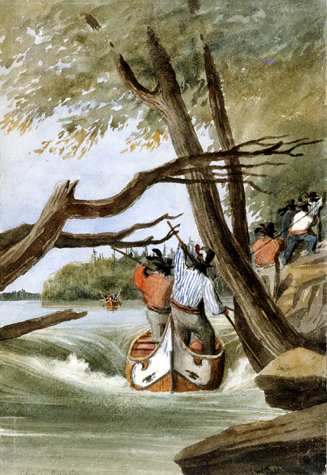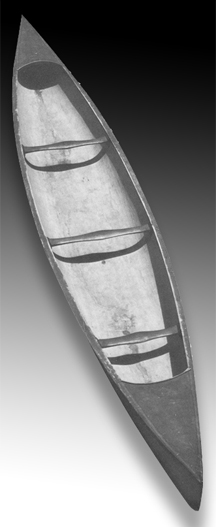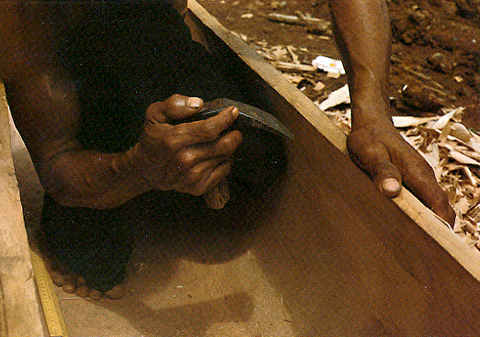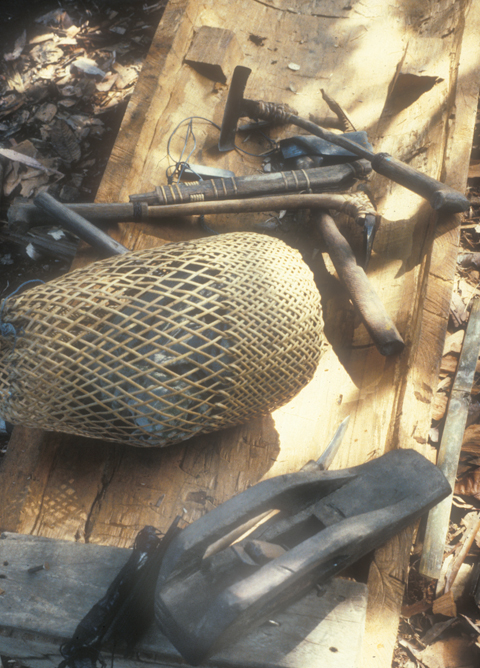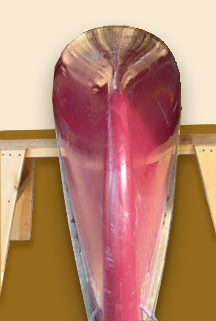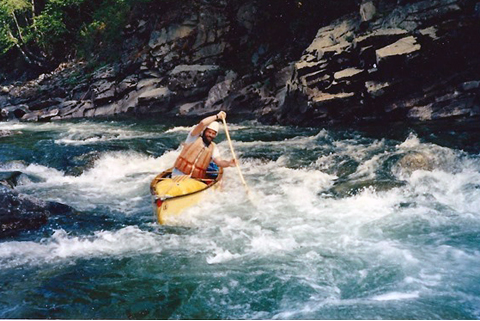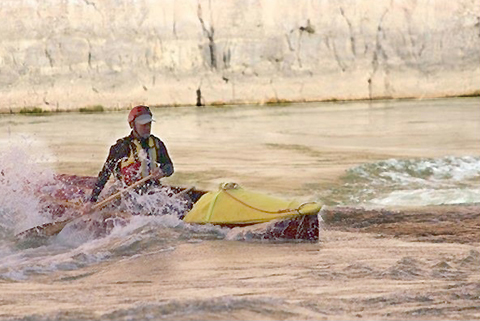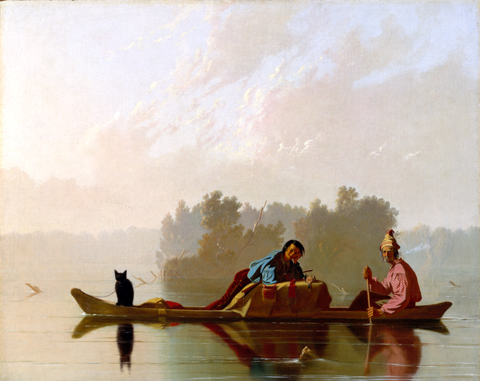Missouri Breaks
With some idea of what kind of river they were ascending, let us look in detail at their journals up through the Missouri Breaks in high water, from near the Musselshell River on 13 May to the Marias, 2 June 1805, perhaps the most interesting three weeks in their entire journey. We need to appreciate their handling of canoes in the context of their daily trials.
On Monday, 13 May 1805, they were below the Musselshell River. Lewis wrote: “The wind continued to blow so violently this morning that we did not think it prudent to set out.” They sent out hunters, and embarked at 1pm, about 6 hours late. They made only 7 miles. Remember, every day they are mainly walking, in the water and on the bank, pulling six canoes with two to three thousand pounds of baggage each, and two pirogues with perhaps ten thousand pounds each.
Bad Day
Tuesday, 14 May 1805: It was 32° at sunrise, and the river was still falling; the runoff had not begun. They made only 16 miles that day, but in the meantime Clark killed a buffalo cow, Lewis walked on shore and killed a calf and large wolf, one of the party shot a grizzly bear but only wounded him, and in one of the famous incidents of the trip, men in the two rear canoes shot a large grizzly, according to Lewis, “about 300 paces from the river, and six of them went out to attack him . . . all good hunters . . . [they] got within 40 paces of him unperceived . . . ” and the rest is history: four men fired and all hit the bear, he charged, the other two men fired, one shot glancing, the other breaking the bear’s shoulder. He nevertheless kept charging, the men had no time to reload; they ran to the river, bear in pursuit, two men jumped in a canoe, the four others hid separately in willows to reload, each shot and hit the bear again, but:
the guns served only to direct the bear to them, in this manner he pursued two of them separately so close that they were obliged to throw aside their guns and pouches and throw themselves into the river altho’ the bank was nearly twenty feet perpendicular; so enraged was this anamal that he plunged into the river only a few feet behind the second man . . . when one of those who still remained on shore shot him through the head and finally killed him.
They butchered the bear and “found eight balls had passed through him . . . the bear being old the flesh was indifferent . . . the skin and fleece made us several gallons of oil.”
But wait, there’s more: “[I]t was after the sun had set [mid-May, perhaps 9 p.m.] before these men come up with us, where we had been halted by an occurrence . . . [which] I cannot recollect but with the utmost trepidation and horror; this is the upsetting and narrow escape of the white pirogue.” Charbono was at the tiller, and both captains were on shore (very unusual), and the pirogue was “under sail when a sudden squall of wind struck her obliquely.”
To follow this famous incident, you need to know something of sailing a canoe or pirogue on a river. The pirogues were certainly longer, much wider and more stable than the canoes, but the sailing principles for both vessels are the same: these are square or lateen rigged, small, narrow boats with no large, heavy keel. If lateen rigged, they might go carefully sideways to the wind, and perhaps slightly up into it, but with no keel or sideboards, very gently. On a lake. When we consider the fast current of the Missouri, and the strength of wind needed to sail up the river at all, we can assume that with either kind of rig they sailed only with a wind from behind–”before the wind.”
When they are sailing upriver with a strong wind behind, whether in a canoe or a pirogue, the current itself also comes into play. In our discussions of crosscurrents, and in multiple videos, the reader is aware that a side current, instead of “pushing” a canoe or pirogue over, passes under the boat, rotating it up into the current. A strong current from your right does not knock the boat over to your left; it rotates the boat to the right, into the current. Therefore, you lean out to your left with a “downstream” or down current brace. Now sailing a boat upstream means you are going very fast against the current; and if the boat turns sideways to the current the wind will try to blow the boat over upstream, while the current is also trying to rotate the boat upstream.
Once my wife, Juliette, and I were in a friendly canoe race down the Blackfoot River in spring’s high water, with maybe twenty boats of pros and amateurs. The start was on the shore: “Racers, run to your boats.” Thirty people in bathing suits and life jackets ran to twenty canoes and pushed them out all at once into a river in flood. It was Memorial Day, about the same week as Lewis at the Musselshell. The day was blustery and cold with mixed rain and snow. When we had all gone not more than a hundred yards downriver, a sudden squall of wind came upriver. We were in my 1911 design wooden Old Town canoe, with a keel. Juliette couldn’t hold the high bow into the wind, we turned sideways to the river flow and–BAM!–we were over in a second; the wind was blowing us upriver, and the side current was also rotating us upriver, especially with a keel, and we were in the water in a second.
Lewis does not give us enough information to say exactly what happened to the white pirogue, but the above principles certainly apply. The pirogue was:
under sail when a sudden squal of wind struck her obliquely, and turned her considerable, the steersman alarmed, in stead of putting her before the wind, lufted her up into it, the wind was so violent that it drew the brace of the suarsail out of the hand of the man who was attending it, and instantly upset the pirogue and would have turned her completely topsaturva, had it not been from the resistance mad by the oarning against the water.
What we know for sure is that sailing a canoe or pirogue upriver is always touchy; that the wind suddenly shifted from upstream to “oblique;” and that at least one oarsman did a low brace: He turned his oar, like a paddle, parallel to the water and pressed down, stopping the boat from turning over–rotating–toward the side of that oar.
What we don’t know is the sailing situation. In a regular sailboat, you turn up into a dangerous wind; you head upwind. The sail luffs, streaming back from the mast, and you slow down. But you cannot head upwind with a square sail rig, and not effectually with a lateen rig on a canoe or pirogue with no keel. Now another factor: Lewis says the wind was “oblique.” Since it was previously from behind, it is probably now quartering from the stern, or maybe from the side. Let’s say the gust is coming from the left rear at 45°. Turning up into requires a turn of 135°, while turning away from it requires a turn of only 45°. Not only is that faster to accomplish, but it does not involve turning the boat completely sideways to the current, at the risk of turning over, to reach your goal: upwind or downwind, with the sail dropped.
Most probably the steersman Charbonneau had a sail boater’s instinctive reaction–in danger, turn up into the wind. But with a square-rigged pirogue or canoe in a current, that was a mistake; turn downwind instead, and if possible do not turn sideways to the current.
We are told three rare facts: First, the sail was a “squarsail,” though I’m not sure we can trust that it was square rigged, versus lateen rigged. A lateen rig sometimes has a disconnected upper boom that makes its shape a lopsided rectangle, rather than a triangle. So “squarsail” might be roughly accurate for some lateen rigs. Second, we are told that, as we expect, a man was always tending the boom or the halyard, for an instant response to such gusts. Unfortunately, we are not told if the square sail’s lower rope or boom was rigged ahead of or behind the mast, so we can’t infer the direction of the wind. Third, Lewis says, “he [Pierre Cruzatte] ordered 2 of the men to throw out the water with some kettles that fortunately were convenient.”
This is a valuable passage. Re-enactors and others have asked how the crew bailed, many times a day, with wind and waves and only four inches of freeboard. It’s never directly discussed. However, as Lewis had read, Alexander Mackenzie used trade pots, also called “kettles.” Now in a boat with the most precious cargo packed into 90 pound bundles, ascending difficult rapids all day, why were “some kettles . . . fortunately . . . convenient,” not tied down in packages. Obviously, they bailed with a “kettle”, which in Webster’s 1806 dictionary is “a kitchen vessel to boil things in,” while a “pot” is almost synonymous: “a vessel for boiling or holding liquids.” Don’t think teakettle; think big kettle. Lewis’s requisitions list includes at least fourteen kettles or pots of 1–5 gallons. A one gallon pot with a handle would resemble modern bailers: a half gallon plastic milk jug scooped out.
Also in this passage, Lewis clearly says “they baled out the canoe,” and two lines later, “the pirogue lay on her side.” He uses the two terms interchangeably, for one boat. At any rate, “the perogue then wrighted, but had filled within an inch of its gunnels.” Much was soaked.
The white pirogue was their best boat, and carried their most precious cargo, “papers, Instruments, books medicine . . . every article indispensably necessary to . . . insure the success of the enterprise.” Lewis dropped his gun and threw off his shot pouch, and was unbuttoning his coat to swim across when he reflected, “the pirogue was 300 yards distant [big river!] the waves so high that a pirogue could scarcely live in any situation [and they were sailing!], the water excessively could, and the stream rappid.”
They made 16½ miles that day, sailing and walking upriver in cold water, on sharp rocks and slippery muddy banks through willows, with squalls and waves, dragging twenty tons of gear in eight boats with little freeboard, doing some hunting (two buffalo, a wolf, a bear), six men barely escaping a crazed grizzly, and their most precious boat almost lost with all papers and instruments. I invite every reader to walk 16½ miles on the level tomorrow, with good shoes, and then imagine doing that in and out of cold water and slippery mud, in moccasins or barefoot, pulling 2-3,000 pound boats against the current. Over the last ten years I have mentioned their twenty-mile days upriver to many canoeists; every time they shake their heads and say, we consider that a full day downstream.
Finally they made camp: “we thought it a proper occasion to console ourselves and cheer the sperits of our men and accordingly took a drink of grog and gave each man a gill of sperits.”
Make mine a double.
15 May 1805 and 16 May 1805: Drying out their cargo. They set out at 4 p.m. on the second day, and made 7 miles to camp. Now wait a minute. You river runners, consider: They packed up all that dried gear and shoved off at 4 p.m. to make 7 miles and unpack? I am not going on a trip with these guys.
17 May 1805 and 18 May 1805: Two 20-21 mile days, banks good for towing, though strong headwinds the second day. Some interesting remarks: Lewis (May 17): “employed the toe line . . . the banks were firm and shore boald (bald, bare) which favored the use of the cord. I find this method of ascending the river, when the shore is such as will permit it, the safest and most expeditious mode of traveling, except with sails in a steady and favourable breze.” That’s a steady breeze, not the squall of the 14th. The side creeks were still dry, and the river still falling, so runoff had not reached that part of the river yet. They had their first rain since setting out from Fort Mandan!
19 May 1805 and 20 May 1805: The night was “disagreeably cold”, said Lewis, and because of fog in the morning they were “unable to set out until 8 oclock A.M.” Clark remarks that “this morning we could not set out until the sun was about 2 hours up.” In other words, they usually embarked near sunrise, in this case, 6 a.m. “The river was croked, rappid and containing more sawyers“, said Lewis. This suggests high water is beginning up above. They reached the Musselshell on the 20th after 7 miles and camped, to make observations. The “water was strong,” said Lewis. Clark: “some very Swift water.” He was not given to exaggeration.
21 May 1805–23 May 1805: These were similar days of strong current and good mileage (20 miles, 16½ miles, and 27 miles on the 23rd). They were using “the chord principally,” and as Lewis adds on the 21st, “but little use of the oars and less with the poles as the bottoms are muddy.” That’s an unusual amount of canoeing detail from the Captains. He also mentions “The bends of the river are Short and Points Covered with Cottonwood.”
Points of Land
The captains mention “points” often, and the trouble they cause. There are two kinds of points common to this section of the Missouri, and for most rivers:
Points on the inside of a bend are common to meandering rivers, here at the inside curve of a river in a bottom land: a cottonwood flat. As the river rounds its bend, it deposits silt on the inside of the bend, in the slack water. Lewis: “the bars & points are rich mud mixed with fine Sand.” (May 21st) This slack water will usually have an eddy of some size, as seen in the river pictures of the previous chapter. The eddy feeds back into the stream at the top, further defining and sometimes scouring the point to a sharp end. Pulling a canoe up this eddy, you must finally pull it out into the very fast current rounding the point, and up and around the point. Lewis and Clark often mention doubling the crew to take each boat around a point.
Points on the outside of a bend are often more dangerous, especially in the Breaks. There, high, unstable cliffs at the outside of a bend are hammered by the current, erosion is severe, and rock or mudslides are common. These slides fall down a gully or straight down into the river at the foot of the cliffs, and they deposit heaps of rock and mud right into the current. If for whatever reason you were lining up the shore that becomes the outside of the bend, and it has a rock fall “point” obstructing the current, and you cannot cross the river here, you must, as with an inside point, pull up the eddy to where the main force of the river is slamming into this rock barrier, and get up and around. This is dangerous since you are dealing with the full force of the river on the outside of a bend, where it hits and erodes a cliff. You do not want to turn over there. Lewis and Clark often mention such points at the mouth of erosion gullies in the Breaks.
Remarkably, “the river falls about an inch each day,” said Clark on 22 May, but on the 23rd, “river beginning to rise.” Like river runners today, they probably stuck a stick into the sand at water’s edge each night. Nevertheless, they made 27 miles. Clark “Saw but five Buffalow a number of Elk & Deer & five bear & 2 Antilopes to day.” I like the “but.”
24 May 1805: Lewis: “We set out at an early hour this morning and proceed on principally by the chord until about 9 A.M. when a fine breeze sprung up from the S.E. and enabled us though the balance of the day to employ our sails to good advantage . . . notwithstanding the courant of the river was very strong.”
In the evening Clark killed a buffalo cow and “we left 2 canoes and six men to dress the cow and bring on the meat.” Those were probably the smaller “scout canoes,” about 20’–24′ long, and obviously manageable, with a load, by three men each.
Clark added: “Breeze afforded us good Sailing, the river rising fast Current very rapid.” They went 24¼ miles.
25 May 1805: The difficult canoeing really begins here. They waited for the canoes with the meat until 8 a.m., then shoved off. Lewis: “we imployed the toe line principally which the banks favored the uce off; the courant strong particularly around the points against which the courant happened to set [outside of bend points], and at the entrances of the little gullies from the hills, those rivulets having brought down considerable quantities of stone and deposited at their entrances forming partial barriers to the water of the river to the distance of 40 or 50 feet from the shore, around these the water run with great violence, and compelled us in some instances to double our force in order to get a perogue or canoe by them.” On 26 May Lewis says, “they doubled their crews.” They never directly mention whether they use stern ropes, but, as we shall see, on 28 May, that puzzle seems to be solved.
Lining a Boat Upriver
The Captains clearly depended upon lining (to the French engagés, cordelling), and given their information from traders and Mackenzie, they certainly expected to line often. Lining, and the expectation of it, bears on canoe design. It’s time to consider this canoeing technique in more detail.
The behavior of the hull in crosscurrents is not limited to paddling across the river. When cordelling, the men must often let out rope at the bow; the current then hits the side of the boat at an angle, and with the stern and bow ropes taut, the current pushes the boat out away from the shore. The 30°-45° angle of the boat is maintained with the help of a stern rope, or a pole from the shore, or men with poles in the boat. This allows a towed boat to go out and around obstacles, or to stay in deeper water off shore.
Fig. 25 shows vividly the balance of the polers, standing in the canoe and pressing their poles hard against the bank to keep the boat out in the current, while the men on the bow rope drag it upstream.
While all this seems complicated and obscure in words, every man on the expedition, after fifteen hundred miles of upriver travel in the pirogues and barge to the Knife River Villages, knew the physics of the situation, and therefore the need for the right hull design. When the boat is held at an angle against the current, the fast water must slide easily under the bow, even if the boat is heavily laden, or the bow will catch the current and the boat may turn over.
It’s safe to say that while lining a boat up the Missouri in high water, they could have faced these situations ten or twenty or countless times a day. And every time they crossed the river for better lining and poling on the other shore, they would face cross currents and eddy seams.
So, a canoe with a wide and fairly flat bottom in the middle, for carrying capacity and stability, with smooth, rounded chines to handle side currents, and a hydrodynamic and slightly raised bow and stern (“rocker”) that would not “catch” the current—such a boat would carry the most pounds of gear up the river most safely with the least energy spent in pulling.
The Captains tell us repeatedly of their use of the rope, and of the necessity of favorable banks for towing, and of the difficulty of pulling boats up and around the points. However, there are many aspects of lining about which they say nothing at all. Even though they have problems with breaking tow ropes, especially when the hemp ropes have been replaced by elk hide, they never say how the ropes were attached. The re-enactors from Idaho, Montana and Missouri helped confirm for me that the following issues are never addressed in the journals:
- How were ropes attached? Some period boats have horizontal holes through the sides of the hull, where the bow is thick. There could also be a single hole a foot or so below the top of the bow. In both cases a rope would be threaded through, looped and knotted. It would be left there permanently, no doubt, for instant and repeated use.
- Modern canoeists often use a sling around the entire canoe, maybe looped under a thwart near the bow, and attach the tow line to the bottom of the sling, under water. This greatly increases the stability of the canoe, especially in a cross current, as the rope is pulling from under the boat instead of high on the bow. But this takes some time to rig, and there is no mention of slings in the journals. It is possible, as we found out in the river tests, that two to four thousand pounds of weight, whether that is a heavy load or a heavy canoe, simply makes the canoe nearly unflippable, so that a sling was unnecessary.
- A stern rope is also not mentioned, although this would seem to be necessary for guiding a boat up, out, and around points. Since poles serve a similar purpose, the expedition may often have had someone with a pole in the stern (as seen in Fig. 25, above). However, muddy bottoms, or deep, fast water, make that solution unlikely, and dangerous for the man standing in the boat. I can’t imagine a pole used only from shore: it would have to be very long, and besides, you often need to pull the stern in, not hold it out.
Though the Captains sometimes remark on this difficulty or that, readers should also be aware that when the water is shallow near shore, that would be preferred walking–in very cold runoff water–and that on shore, even when it was fine towing, the rope pullers encountered not just sharp rocks and mud but Missouri bentonite gumbo, slick as ice, and prickly pear cactus, low, hard to see, and nasty.
All of this was no doubt part of their story, even if untold, on 25 May, when they had to “double our force” ascending against “current strong particularly around points and gullies” creating “barriers 40-50′ from shore.” And another problem had begun: Clark: “the last rains has raised the river a little.” They made 18 miles that day.
26 May 1805: Another rare canoeing detail from Lewis: “Set out at an early hour and proceeded principally by the toe line, using the oars [meaning paddles also] mearly to pass the river in order to take advantage of the shores.” The Missouri sometimes has eddies a mile long, and since it is a fairly sinuous river, there are many bends, most of which will have an eddy on the inside of the bend. Usually the bends alternate: left, right, etc., making it advantageous to cross every few miles. Also, the banks at the inside of a bend are often low and smooth, good for lining, while the outside of the bend is faster water and may be up against cliffs. Since I was certain that unless they were sailing, they would want to cross the river to take advantage of these eddies and better shores for lining, at the inside of each bend, I was pleased to have Lewis acknowledge that practice. The “mearly” suggests that crossing the river “to take advantage of the shores” is hardly worth mentioning. But remember this remark, for crossing eddy seams and handling crosscurrents and upstream ferries, is the work of a river canoe with chines and some rocker, not a Nez Perce fishing boat.
Bird Rapid
Late that day, they came to one of their most difficult rapids: Elk Fawn rapid, now called Bird Rapid. Lewis: “Late this evening we passed a very bad rappid which reached quite across the river, . . . the party had considerable difficulty in ascending it altho’ they doubled their crews and used both the rope and the pole. While they were passing this rappid a female elk and its fawn swam down through the waves which ran very high . . . these are the most considerable rappids which we have yet seen on the Missouri and in short the only place where there has appeared to be a suddon decent.” They did not know that a series of 23 more rapids awaited them as they ascended the next hundred miles.
Many quite difficult rapids show very little “drop,” but when you’re looking at a volume of water dropping 10 or 20 feet in a few hundred yards or so, you are aware of something different. The problem is not only hitting rocks; it’s being buried by waves.
Clark adds: “we passed a rapid which extended quite across the river we assended it by the assistance of a Cord & poles on the Lard. Side [left] the cliffs jut over, the opposite side is a small leavel bottom, we Camped a little above in a Small grove of Cotton trees on the Lard. Side.” The rapid exists today, but it has been dredged, and is probably much changed, and the river is dammed above.
Using the Missouri River Commission maps of 1892-95, after the river was dredged but before it was dammed, we can see something of what they faced that week. Bird Rapid was the first, when ascending, of five rapids in six miles, and above that there was another sequence of five rapids in six miles. And there were probably many more rough spots in 1805, before the steamboat captains had them cleared them out. They made 22½ miles that day, dragging eight boats and twenty tons upstream.
They began almost a week of rising water, more difficult rapids, and hard towing, entering the worst section of the Breaks just as the river approached its crest.
27 May 1805: Again the wind blew and they could not set out until 10 a.m. The wind probably created waves that could swamp the boats. Lewis: “we employed the chord most of the day; the river becomes more rappid and is intercepted by shoals and a greater number of rocky points at the mouths of the little gullies . . . the bluffs are very high steep rugged, containing considerable quantities of stone and border the river closely on both sides . . . . the river is generally about 200 yds. Wide, very rappid and has a perceptible fall or declination through it’s whole course.”
Clark adds: “The river is very Shoaly [Probably, in high water, meaning overrunning gravel bars and features that might be above the water at low levels] and the bad places are very numerous, i e at the mouth of every Drean [drain, gully] the rocks which is a hard dark gritey Stone is thrown out at Some distance in the river which Cause a Considerable riffle on that Side.”
Remember that they are ascending by line; portaging is never mentioned until the Great Falls. They need not only a passage for the boats up through these rapids (that’s all you need going down), but a place to walk. And again, many could not swim.
They made 14 miles that day. River rising.
28 May 1805: We have covered the principles, and the kinds of challenges they were encountering. Now, the challenges become continuous. Lewis writes:
. . . employed the chord generally to which we also gave the assistance of the pole at the riffles and rocky points; these are as numerous and many of them much worse than those we passed yesterday; around these points the water drives with great force, and we are obliged in many instances to steer our vessels through the appertures formed by the points of large sharp rocks which reach a few inches above the surface of the water, here [Should] our cord give way the bough [bow] is instantly driven outwards by the stream [implies a stern rope or pole?] and the vessel thrown with her side on the rocks where she must inevitably overset or perhaps be dashed to pieces; our ropes are but slender, all of them except one being made of Elk’s skin and much woarn, frequently wet and exposed to the heat of the weather are weak and rotten; they have given way several times in the course of the day but happily at such places that our vessel had room to wheel free of the rocks and therefore escaped injury; with every precaution we can take it is with much labour and infinite risk that we are enabled to get around these points.”
Stern Rope?
Wheel free” gives a stronger impression of a fixed point at the stern, whether it is a stern rope to shore, or a poling man in the stern of the canoe. A canoe with only a bow rope, when that breaks, begins immediately to float backwards, but it does not necessarily turn until it hits currents or rocks. I believe this passage gives us a reasonably clear answer to the important question: was a stern rope used? Any canoeist can tell you that it is almost impossible to line without a stern rope, unless the river is deep enough to float your boat, and shallow enough to walk ahead of the boat, in the water, on a walkable bottom. If you are simply walking on the bank, you will keep pulling the canoe into the bank. When you come to a rock, or tree trunk in the water, or a “point,” a stern rope or a man with a pole in the stern is necessary. Now here, two facts strongly suggest a stern rope. First, as always, the canoe turning broadside to the current and rocks is the problem. Second, if bow ropes are breaking several times a day, but no canoe gets away, there is almost certainly a second rope attached, to haul it to shore. We never read of a canoe floating down river, the crew racing down the bank and swimming out to retrieve it. And expecting frequent rope breaks, it would be folly not to have a second rope. That rope was at the stern, which is why the boats wheeled; but it enabled the crew to bring boats ashore and repair the bow rope. In spite of these difficulties, including ropes breaking “several times in the course of the day,” they made 21½ miles. Upriver. Hauling twenty tons.
29 May 1805: During the night, a “large buffaloe Bull” swam across the river and “coming along side of the white pirogue, clambered over it to land.” This confirms what we would assume: that the heavy loads in heavy boats were tied, or beached and tied, at night, not necessarily unpacked. They proceeded by cord past the Judith River, where Lewis “counted the remains of the fires of 126 Indian lodges” (tepees), less than two weeks or so old, he guessed.
Lewis writes that they came to “a very bad rappid to which we gave the name of the Ash rappid [later Drowned Man or Deadman] the rocky points and riffles rather more numerous and worse.” They passed a buffalo jump, with many wolves about, and put in for their afternoon dinner. They had made 17¾ miles. Clark continues: “Soon after we Came too it began to rain & blow hard, and as we were in a good harbor & Small point of woods . . . conclude to stay all night.” Even a downstream wind on the Missouri can easily kick up 2–3 foot waves, wetting cargo: Gale force gusts (40 mph) are not uncommon, especially in the spring. Descending, I have been blown upriver by headwinds; controlling a canoe while travelling backwards upstream, is interesting. First, you get down on your knees, fast.
“Without a Murmur”
30 May 1805: River still rising. Lewis:
The rain which commenced last evening continued with little intermission until 11 this morning when we set out; the high wind which accompanied the rain rendered it impracticable to procede earlier . . . . we proceded with more labour and difficulty than we have yet experienced; in addition to the imbarrasments of the rappid courant, riffles & rockey point which were as bad if not worse than yesterday, the banks and sides of the bluff were more steep than usual and were now rendered so slippery by the late rain that the men could scarcely walk. the chord is our only dependence for the courant is too rappid to be resisted with the oar and the river too deep in most places for the pole. the earth and stone also falling from these immence high bluffs render it dangerous to pass under them. the wind was also hard and against us. our chords broke several times today
Clark: “those rapids or Shoaley points are noumerous and dificuelt, one being at the mouth of every drean.” That “drean” is Kentucky-talk for drain, or gully; and here shoal is synonymous with rapid. They make only 8 miles that day.
31 May 1805: This day’s even rougher, and the river is still rising. The two pirogues leave first; the canoes follow with the meat of two buffalo killed the night before. Lewis finally mentions the cold water of snowmelt. He writes:
The obstructions of rocky points and riffles still continue as yesterday; at those places the men are compelled to be (much) in the water even to their armpits, and the water is yet very could, and so frequent are these point[s] that they are one fourth of their time in the water, added to this . . . the banks and bluffs along which they are obliged to pass are so slippery and the mud so tenacious that they are unable to wear their mockersons, and in that situation dragging the heavy burthen of a canoe and walking occasionally for several hundred yards over the sharp fragments of rocks which tumble from the cliffs. . . in short their labour is incredibly painfull and great, yet those faithful fellows bear it without a murmur.
The tow rope of the white pirogue—the only hemp rope left—broke “at a bad point,” and their most precious boat “swung and most slightly touched a rock.” Clark was in the boat, probably with a pole, and testified: “we were in Some danger of turning over.”
River still rising. They made 18 miles.
1 June 1805: The worst is over. The points and shoals are less frequent. The river now holds steady at its crest for three days, then begins to fall. The country opens up, the cliffs are further back and lower, the banks better for towing. They make 18 miles, and camp that night at the mouth of the Marias. They spend six days choosing between the Marias and the Missouri as the correct route, and then by 14 June 1805 they are at the Great Falls, scouting for a portage, and high water is over. Although they will have some work on the shallow and fast Jefferson River, the major upstream canoeing of the entire expedition, through the Missouri breaks in high water, is finished. On the return, up the Snake and Clearwater, they will travel mainly by horse.
Their ascent of the Missouri, from 14 May to 1 June, is to my mind one of the more remarkable tales of perseverance and endurance on record.
Now, knowing what they actually faced, let’s return to the question of what sort of canoes they might have made.
A Beautiful Boat
Clark and Cruzatte were in the cottonwood grove near Fort Mandan in February 1805, ready to make dugouts to ascend the upper Missouri in Spring’s high water. They could expect a much faster river as they approached the mountains, they had information from traders and Indians, and they had Mackenzie’s journals.
The first question is, how much were they limited in their design choices; that is, how finely could a dugout be carved from a tree with the tools of that time? The photograph at right (Fig. 26) of a dugout made circa 1840 in Ontario with hand tools, probably ax, adze, maybe hand adze and drawknife, is the most extraordinary example I have found of fine dugout workmanship using the same tools Lewis and Clark carried.
The thwarts and decking are apparently added, but the rest is one hollowed log. In the 1830’s and 40’s in Ontario, various dugout makers began competing, making canoes for races and regattas. Their tools, however, and their material—a log—were the same as those available to Lewis and Clark thirty years earlier, though basswood is much better than cottonwood for fine work. A carpenter friend tells me that basswood responds to the knife like a hardwood, but is light and buoyant—the perfect wood for a dugout canoe.
Samuel Strickland of Lakefield, Ontario, made the canoe pictured at right (Fig. 26). After the rough shape was attained, the canoes were shaved down and Strickland said, “My boys and I have made canoes of this sort so light, that one person could easily carry one of them on his head over short portages.” I’d guess that meant 80–150 pounds maximum for a 12–14 foot dugout (typical solo size of that time). My guess is on the heavy side: I’m assuming the Strickland boys were strong; and the boat might have been 16 foot. My 1911 design 17 foot Old Town is 70 pounds in ash ribs, cedar planks and canvas. Strickland’s son George had begun making such ribbed and planked canoes on dugout molds by 1860. The new ribbed design was lighter than dugouts, but perhaps not as much lighter as we often assume. And the hull shape was the same: “on dugout molds.”
The same tools that Lewis and Clark and Samuel Strickland used—mainly axe, adze, hand adze and chisel—are still used by Carib Indian descendants in Dominica to make dugouts for ocean fishing and trade between islands.
Lewis and Clark carried those tools, and many more. They could have carved what they wanted, within the limits of their trees. While the re-enactors may want heavy, stable boats (3 inches at the sides, seven at the bottom), the expedition crew probably did not. Chittenden’s dimensions, which were also approximately those of the Nez Perce canoes—one inch sides, two inches at the bottom—were more likely the norm.
A Note on Stability
The first thing most people think of when you say “canoe,” is “tippy.” While it’s certainly true that you must step into it dead center, with hands putting weight equally on both gunnels (not necessary in a rowboat), the issue of stability is very subtle. Stability is learned. A bicycle is impossible to balance, until you learn. Same with ice skating—gliding backwards on one narrow blade. Balance, stability, is achieved through small muscle control that is gained only through practice. Stability is not inherent in the object—canoe, skate, bike—but in the person balancing. That is one reason that I immediately associated the re-enactors’ extremely stable, heavy canoes, with inexperience. And that made me wonder if they might need such craft, while Lewis and Clark did not.
Several years ago I bought this new “Yellowstone Solo” canoe from Bell (Fig. 29). It is a very narrow canoe in Royalex, with an unusually round bottom, making it fast but tippy. This is a hull made for downriver paddling, but with enough rocker to have some whitewater capacity. Also, the gunnels throw off waves and spray quite well.
My old whitewater boat (Fig. 30) was fat, blunt, two ends of two busted Explorers glued together about 1970 by the Mad River Canoe makers, as a prototype for the first solo, whitewater, production canoe in the United States:
That old Mad River canoe was very stable, the new Bell canoe very tippy. When I first got in the Bell in the spring, on a serene river, I was immediately vibrating side to side and thinking “Oh my God, what have I bought?” After sixty years of canoeing, I felt sure I would turn over in calm water. But in two hundred yards, the crisis had eased. After two hours, I was comfortable. In October, I paddled it down the Grand Canyon (Fig. 20) where, as you can see, it looked very small.
Balance is learned, and learned quickly. In an age of river travel, stability in the canoes was not a big issue for the young men hand picked for the expedition.
With low freeboard, and the boy’s weight up high, way above the gunnels of the delicate canoe, Bingham’s picture is a portrait of precarious serenity. A wonderful paradox—precarious serenity—and a large part of canoeing, and of the painting’s appeal.
I think Bingham captured that feeling of downriver ease, the paddle hardly moving, the current sliding around the rock, the occupants, including the cat relaxed and happy in the fragile craft on a huge river. Bingham lived in Missouri most of his life. He painted “Fur Traders Descending the Missouri” in 1854. When Bingham painted those fur traders, Mark Twain (Samuel Clemens) was only nineteen years old, growing up in Hannibal, on the Mississippi about sixty miles north of Bingham’s scene. The painting reminds me of Huck Finn: “It’s mighty free and easy on a raft.” And that painting is only fifty years after Lewis and Clark, and on the same river that Lewis and Clark descended. I have looked at the original painting in the Metropolitan Museum in New York, with a magnifying glass. It’s a dugout. Pretty delicate, eh?
